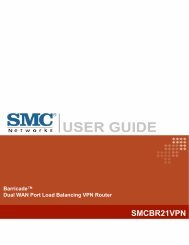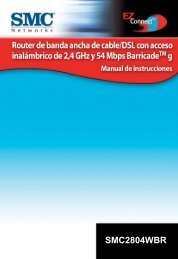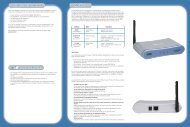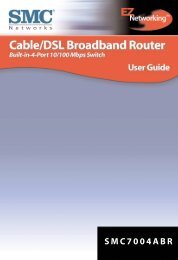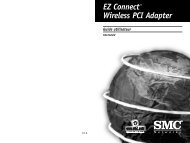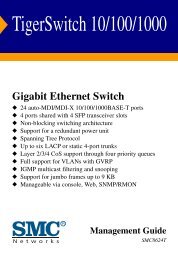User Guide - SMC
User Guide - SMC
User Guide - SMC
Create successful ePaper yourself
Turn your PDF publications into a flip-book with our unique Google optimized e-Paper software.
Understanding Wireless Security<br />
8<br />
Understanding<br />
Wireless Security<br />
Anyone within range of your wireless network is a potential<br />
security risk. Without wireless security options configured on your<br />
network, a person outside of your physical location, but within<br />
your wireless range may be able to access the network and any<br />
data that is being transmitted over it. <strong>SMC</strong> Networks’ wireless<br />
devices support the wireless security standard called Wired<br />
Equivalent Privacy (WEP) to prevent unauthorized users from<br />
accessing your network over a wireless connection. This security<br />
feature uses a secure network key, called a WEP key. The WEP<br />
key encrypts wireless data so that it is only readable by other<br />
computers that have the matching WEP key. The WEP key is<br />
stored on each wireless device, so that data can be encrypted<br />
and decrypted as it is transmitted over the network.<br />
While the Institute of Electrical & Electronics Engineers (IEEE)<br />
802.11i standard is being finalized, an interim solution called<br />
Wi-Fi Protected Access (WPA) has been introduced. The EZ<br />
Connect g Wireless Ethernet Bridge is the first device of its<br />
kind to support this new wireless security specification. WPA<br />
defines a set of interoperable security enhancements that greatly<br />
improve upon the level of data encryption and authentication or<br />
access control for existing and future wireless LAN systems. WPA<br />
includes Extensible Authentication Protocol (EAP), Temporal Key<br />
Integrity Protocol (TKIP) and 802.1X for authentication and<br />
dynamic key exchange. In the WPA-enabled network, the client<br />
first associates with the Access Point. The Access Point does not<br />
allow network access until the user can be successfully<br />
authenticated. If the client shows the correct credentials to the



